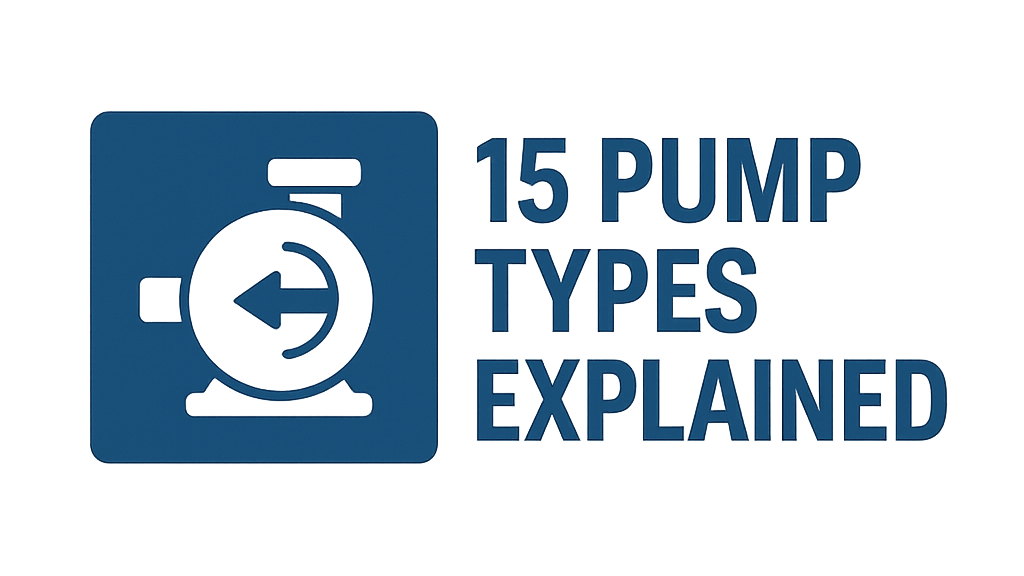15 Pump Types Explained
A Comprehensive Guide to Fluid Movers
Introduction to Pumps
Pumps are mechanical devices used to move fluids (liquids or gases) by raising or circulating them. They are essential in countless applications, from supplying water to our homes to driving complex industrial processes. Pumps achieve this by converting mechanical energy (often from an electric motor, engine, or manual power) into hydraulic energy (flow and pressure). Understanding the different types of pumps and their operating principles is crucial for selecting the right pump for a specific task.
Pumps are broadly classified into two main categories: Positive Displacement Pumps and Dynamic (Centrifugal) Pumps.
Positive Displacement (PD) Pumps
PD pumps move fluid by trapping a fixed amount and forcing (displacing) that trapped volume into the discharge pipe. They deliver a nearly constant flow rate regardless of discharge pressure (within limits).
Gear Pump
Uses meshing gears to trap and move fluid. Can be external (gears outside each other) or internal (one gear inside another). Simple, compact.
Best for: Viscous fluids, oils, chemicals, fixed flow rates.
Lobe Pump
Similar to gear pumps but lobes do not touch. Gentle handling of fluids, suitable for shear-sensitive products and solids.
Best for: Food processing, pharmaceuticals, slurries, viscous liquids.
Vane Pump
Sliding vanes mounted on an offset rotor create expanding/contracting volumes to move fluid. Can handle thin liquids well.
Best for: Fuels, solvents, hydraulics, low viscosity fluids.
Piston Pump
A reciprocating piston moves back and forth in a cylinder, drawing fluid in and pushing it out. Can generate high pressures.
Best for: High-pressure washing, metering, hydraulics.
Plunger Pump
Similar to piston pumps but uses a solid plunger. Typically for higher pressures than piston pumps. Good for abrasive fluids with proper sealing.
Best for: Very high pressures, dosing, reverse osmosis.
Diaphragm Pump
A flexible diaphragm moves back and forth, driven pneumatically (AODD), mechanically, or hydraulically, to pump fluid. Good for corrosives, abrasives, and shear-sensitive fluids.
Best for: Chemicals, slurries, paints, food products, wastewater.
Peristaltic Pump (Hose Pump)
Rollers or shoes compress a flexible tube in a circular casing, pushing fluid through. Fluid only contacts the tube. Excellent for sterile or aggressive fluids.
Best for: Medical, lab, food, chemical dosing, shear-sensitive fluids.
Screw Pump
One or more rotating screws trap and move fluid axially. Progressive cavity (single screw) or multiple screw (twin, triple) types. Handles high viscosity and solids.
Best for: Viscous oils, slurries, wastewater, food products, multiphase flow.
Dynamic (Centrifugal) Pumps
Dynamic pumps add energy to the fluid by increasing its velocity, primarily using a rotating impeller. The velocity energy is then converted into pressure energy.
Centrifugal Pump (Radial Flow)
Most common pump type. Fluid enters axially and is accelerated radially outwards by an impeller. Versatile, wide range of capacities and heads.
Best for: Water supply, irrigation, HVAC, general industrial, chemical transfer.
Axial Flow Pump
Propeller-like impeller moves fluid axially (parallel to the shaft). High flow rates at low heads. Often used for dewatering, flood control.
Best for: High volume, low head applications like drainage, irrigation, circulation.
Mixed Flow Pump
Combines radial and axial flow characteristics. Impeller discharges fluid at an angle to the shaft. Medium flow rates at medium heads.
Best for: Municipal water, wastewater, irrigation, flood control.
Submersible Pump
Pump and motor are hermetically sealed and submerged in the fluid being pumped. Typically centrifugal type. Prevents cavitation issues.
Best for: Borewells, sump drainage, wastewater, dewatering.
Multistage Centrifugal Pump
Multiple impellers on a single shaft in series within a common casing. Each stage increases the pressure. Used for high head applications.
Best for: Boiler feedwater, reverse osmosis, high-pressure cleaning, boosting pressure.
Self-Priming Centrifugal Pump
Designed to lift fluid from a level below the pump suction without needing external priming after the initial prime. Retains fluid in casing.
Best for: Sump emptying, dewatering, irrigation where suction lift is required.
Vertical Turbine Pump
Centrifugal or mixed flow impellers in a series of bowls, suspended by a column pipe. Motor is typically above ground. Used for deep wells or sumps.
Best for: Deep well pumping, irrigation, municipal water supply, cooling towers.
General Pump Selection Factors
Choosing the right pump involves considering many variables:
- Fluid Properties: Viscosity, density, temperature, corrosiveness, abrasiveness, presence of solids, shear sensitivity.
- System Requirements: Required flow rate (capacity), total dynamic head (pressure).
- Suction Conditions: NPSHa (Net Positive Suction Head available) vs. NPSHr (required).
- Operating Environment: Temperature, hazardous area classification, space limitations.
- Efficiency & Energy Costs: Pump efficiency at duty point, lifecycle costs.
- Materials of Construction: Compatibility with fluid and environment.
- Maintenance Requirements & Reliability.
- Initial Cost vs. Total Cost of Ownership.
- Noise Levels.
- Type of Drive: Electric motor, engine, etc.
Choosing the Right Mover for Your Fluid
The world of pumps is diverse, with each type engineered for specific tasks and fluid characteristics. From the robust simplicity of a centrifugal pump to the precise delivery of a diaphragm pump, understanding their fundamental differences is key to efficient and reliable system design. Careful consideration of application requirements, fluid properties, and operational conditions will guide the selection of the optimal pump, ensuring performance, longevity, and cost-effectiveness.

